Start your yoga journey with foundational poses like Easy Pose (Sukhasana) for relaxation and mindfulness. Warm up your spine with Cat-Cow Stretch, and build strength and balance with Tree Pose (Vrksasana). Downward-Facing Dog stretches multiple muscle groups while Child's Pose (Balasana) offers deep relaxation. Standing tall in Mountain Pose (Tadasana) promotes alignment and posture. Incorporate Bridge Pose for back and hamstring strength, then finish with Corpse Pose (Savasana) for full-body relaxation. Proper alignment is essential; it improves posture and reduces back pain. To deepen your practice and explore more techniques, further insights await.
Key Takeaways
- Start with basic poses like Easy Pose, Tree Pose, and Downward-Facing Dog to build a strong foundation.
- Focus on proper alignment to prevent injuries and enhance posture.
- Use props like blocks and straps to support your body and improve flexibility.
- Incorporate relaxation poses like Child's Pose and Corpse Pose to calm the mind and body.
- Practice regularly and listen to your body to gradually increase flexibility and strength.
Easy Pose (Sukhasana)
Easy Pose (Sukhasana) is a simple yet powerful seated position that helps you relax and relieve stress. Picture yourself sitting cross-legged like a serene yoga master, but without the pretzel-like complexity.
This pose, or Easy Pose, keeps things chill and straightforward. Sit with a straight spine, allowing your hips, knees, and thighs to open up like a well-oiled door. Need a boost? Pop a prop under your buttocks for added comfort.
Just five full breaths can work wonders, improving your posture, flexibility, and mindfulness. It's beginner-friendly, so no need to twist into a human knot. Give Sukhasana a try, and you'll be on your way to zen bliss in no time!
Cat-Cow Stretch
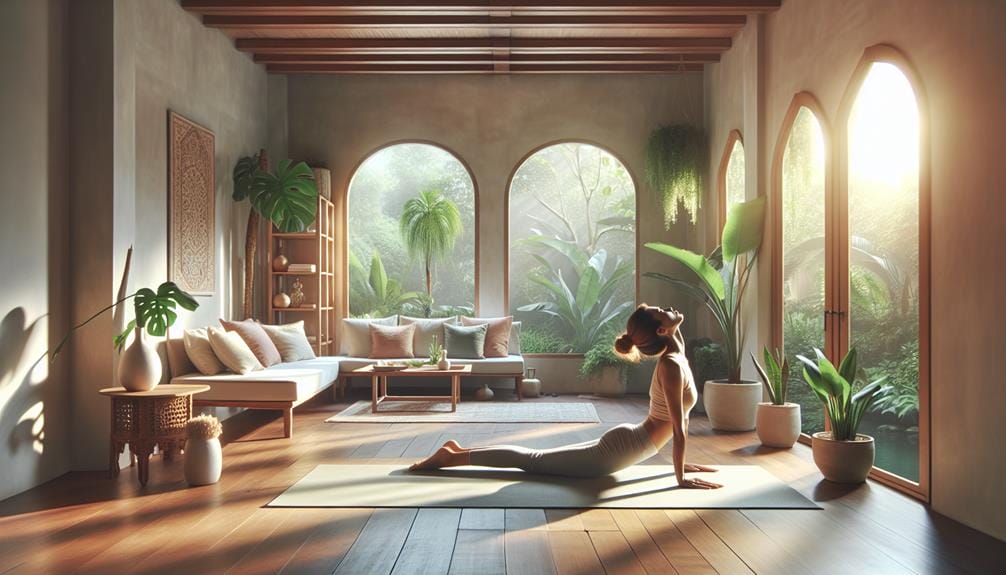
The Cat-Cow Stretch, a gentle yoga sequence, helps warm up your spine and improve flexibility. This delightful duo involves arching your back (Cow Pose) and rounding it (Cat Pose), making your spine feel like it's on a mini-vacation. Not only does it relieve lower back pain and improve posture, but it also gives your abdominal organs a nice little massage.
Here's a quick breakdown of the benefits:
| Benefit | Description |
|---|---|
| Spine Flexibility | Increases mobility and warms up the spine |
| Stress Relief | Helps alleviate stress and promotes relaxation |
| Digestive Health | Massages abdominal organs for better digestion |
Try it out and let your spine thank you with a happy wiggle!
Tree Pose (Vrksasana)
Tree Pose (Vrksasana) helps you find your balance while strengthening various muscle groups, including your ankles, calves, and abs.
Start by placing one foot on your calf or thigh and use a wall for support if needed.
Practicing this pose regularly enhances your posture, concentration, and overall stability.
Finding Your Balance
Standing tall like a tree, you'll find balance and strength in the Tree Pose (Vrksasana), a fundamental posture in yoga.
Imagine channeling your inner oak, firmly rooted yet reaching for the sky. This pose will have your ankles, calves, quads, and abs saying, 'Let's get stable!'
Focus on a single point ahead to keep from wobbling like a jelly-legged flamingo. If you're feeling extra wobbly, place your foot on your calf instead of your inner thigh.
With regular practice, Tree Pose won't only stretch your hips, ankles, and feet, but also improve your overall posture and alignment.
Proper Foot Placement
For proper foot placement in Tree Pose (Vrksasana), start by placing the sole of your foot against your inner thigh or calf, but never on your knee. Trust me, your knees will thank you for it!
If you're new to this, keep your toes on the ground for support. Once you're feeling brave, lift that foot higher. Remember, good foot alignment is key to finding your balance.
Engage your core and fix your gaze on a point in front of you (a drishti) to help with concentration. Proper foot placement won't only make you look like a majestic tree but will also strengthen your ankles and calves.
Benefits of Tree Pose
You'll find that practicing Vrksasana strengthens your ankles, calves, and thighs, greatly enhancing your balance and stability. Not only does Tree Pose help you stand tall without wobbling like a penguin on ice, but it also stretches your hips and inner thighs, making those tight spots more flexible. As you balance, you'll engage your core muscles, giving your abs a sneaky workout. Plus, with regular practice, Tree Pose can improve your posture and alignment, making you look as regal as a yoga master.
Here's a quick rundown of the benefits:
| Benefit | Area Improved |
|---|---|
| Strengthens muscles | Ankles, calves, thighs |
| Enhances flexibility | Hips, inner thighs |
| Promotes mental clarity | Focus, concentration |
Downward-Facing Dog

Downward-Facing Dog (Adho Mukha Svanasana) is a fundamental yoga pose that stretches and strengthens multiple muscle groups while calming the mind and energizing the body. It's like a multitasking superhero for your yoga practice!
This pose stretches your back, shoulders, hamstrings, and calves, making you feel like a bendy pretzel. Plus, it strengthens your arms, shoulders, and core muscles—hello, upper body workout!
To nail this pose, press into your hands and engage your core. Don't forget to lengthen your spine and keep those heels grounded. If you're feeling stiff, bend your knees slightly or use blocks for support.
Child's Pose (Balasana)
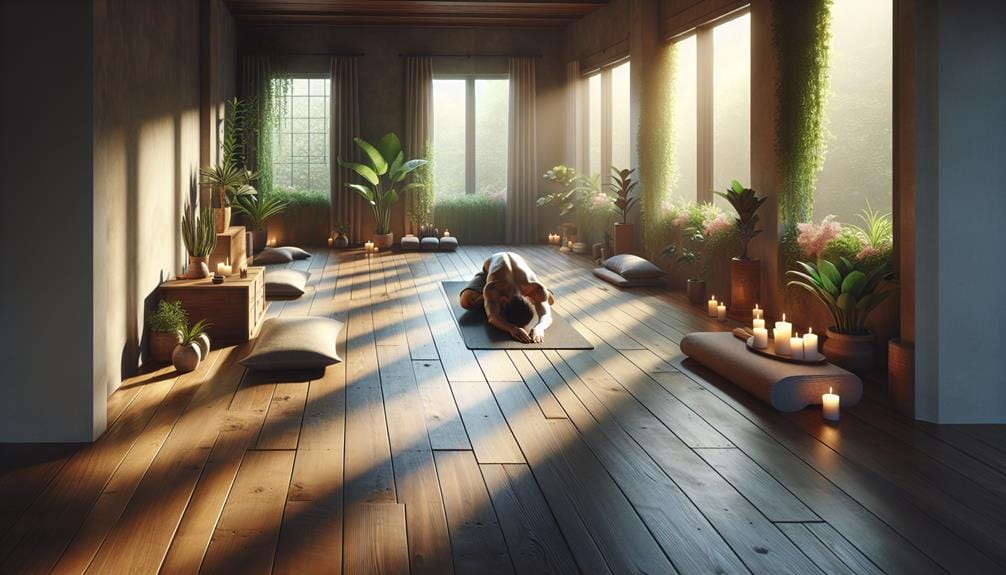
Child's Pose (Balasana) is a simple yet effective resting pose that helps calm your mind and relax your body.
To perform it correctly, start by kneeling on the floor, then sit back on your heels and stretch your arms forward while lowering your forehead to the mat.
This pose gently stretches your hips, thighs, and ankles, making it an excellent choice for beginners to release tension and find a moment of rest between more challenging postures.
Benefits of Child's Pose
Embracing the restful nature of Balasana, you can calm your mind and relieve stress effectively. Child's Pose is your go-to for a mini-vacation on the yoga mat, stretching your hips, thighs, and ankles while promoting relaxation.
Feeling like a human pretzel? This pose helps with that too! It's a lifesaver for back and neck pain, perfect for beginners or those with tight muscles. Plus, it's got some sneaky benefits:
- Improves digestion – Who knew kneeling could help your tummy?
- Enhances flexibility – Your spine will thank you.
- Provides emotional release – Because sometimes, we all need a good cry on the mat.
Steps to Perform Correctly
To get into Child's Pose correctly, start by kneeling on the mat with your big toes touching and your knees spread apart.
Now, sit back on your heels like you're pretending to be a human origami project. Extend your arms forward with palms resting on the mat.
This beginner yoga pose is perfect for when you need a break from pretending you know what you're doing. Focus on deep breathing—inhale the good vibes, exhale the stress.
Feel the gentle stretch in your hips, thighs, and ankles. Child's Pose is a staple in yoga for beginners, offering a mini-vacation for your back, shoulders, and chest.
Use it to calm your mind and recharge between more challenging yoga sequences.
Baby Pigeon Pose
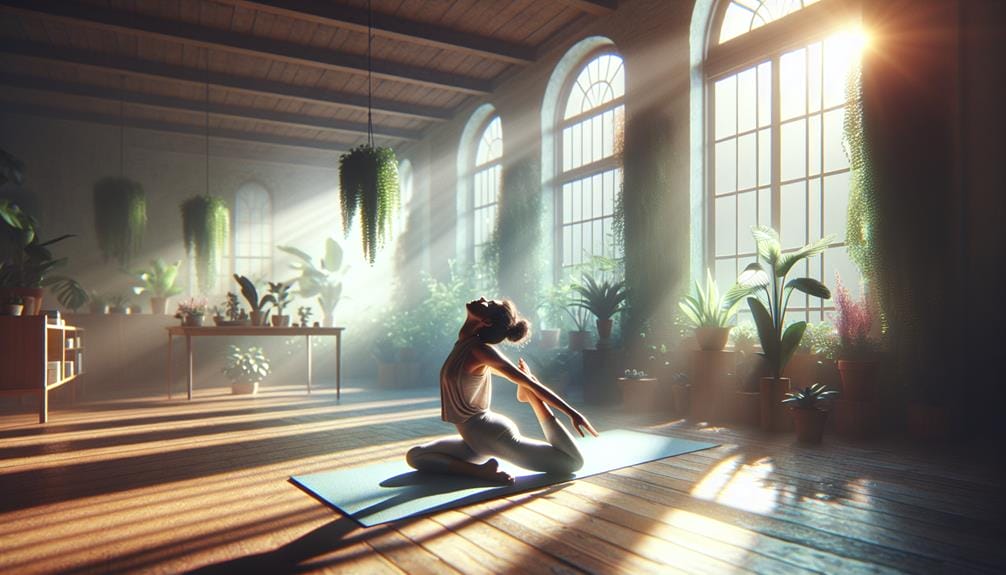
Although often overlooked, Baby Pigeon Pose (Eka Pada Rajakapotasana) is essential for stretching tight hip flexors, glutes, and piriformis muscles. If you've been sitting like a statue or running like Forrest Gump, this pose is your new best friend. Regularly practicing Baby Pigeon Pose can enhance hip flexibility and help reduce lower back pain.
To get the most out of this pose, follow these tips:
- Support with Props: Place a yoga block under your hip for added comfort and stability. There's no shame in a little extra support!
- Align Properly: Keep your front leg bent at a 90-degree angle to avoid strain.
- Breathe Deeply: Inhale courage, exhale tension. Trust us, your hips will thank you.
Legs-Up-The-Wall
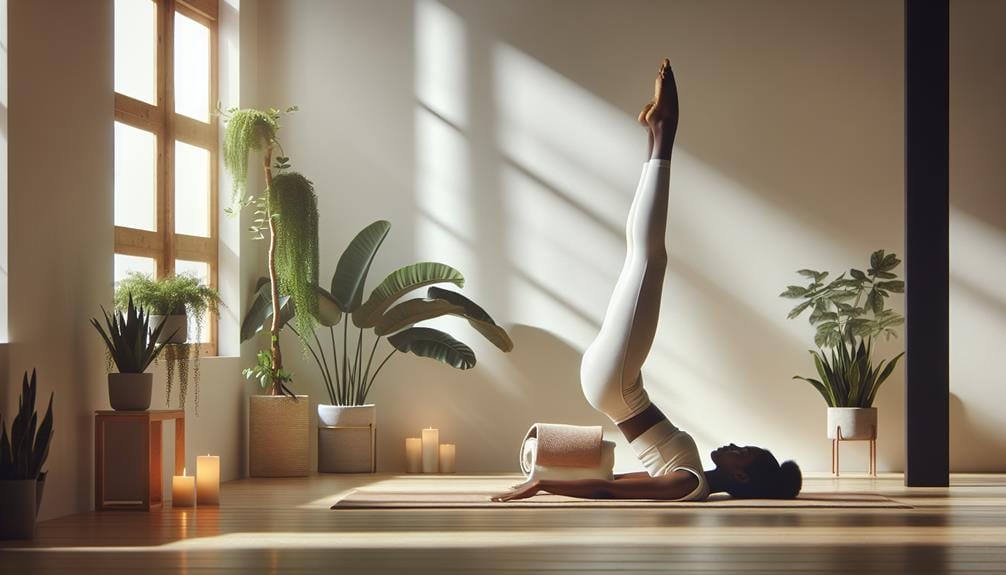
After working on your hip flexibility with Baby Pigeon Pose, it's time to elevate your relaxation with Legs-Up-The-Wall.
Imagine lying on your back, legs straight up against the wall, looking like a human L. This pose is fantastic for alleviating lower back pain and easing anxiety. Just let gravity do its thing and feel the relaxation wash over you.
Hold it for 5-15 minutes, and you might just forget what stress feels like. It's also great for improving circulation and reducing leg swelling. Regular practice can help you sleep like a baby and make your legs feel less like they've run a marathon.
Mountain Pose (Tadasana)
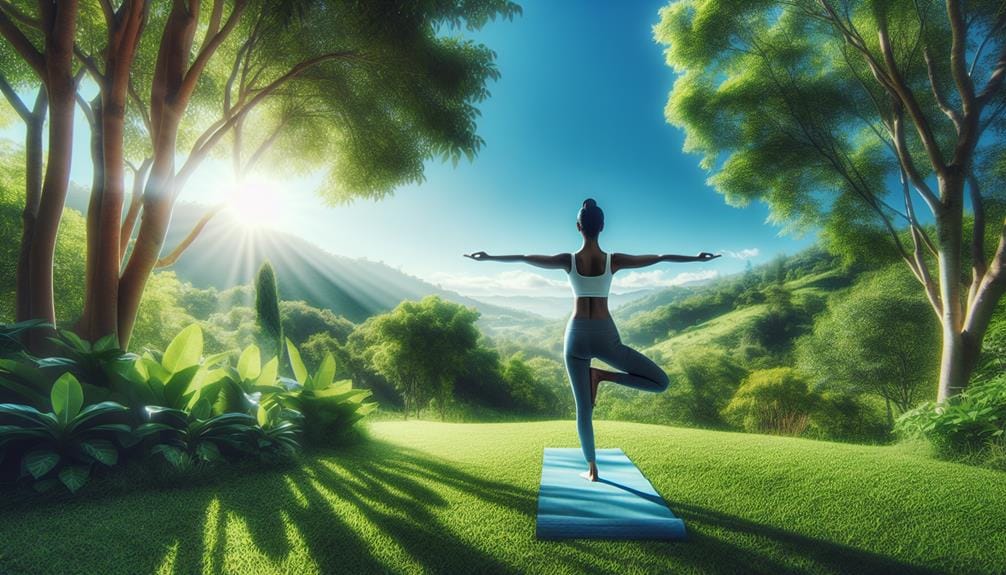
In Mountain Pose (Tadasana), you'll stand tall with your feet hip-width apart and arms at your sides, palms facing forward.
Focus on proper alignment by distributing your weight evenly through the soles of your feet, which helps improve balance and posture.
This foundational pose builds strength in your lower body and core while enhancing overall body awareness.
Proper Alignment Techniques
Achieving proper alignment in Mountain Pose (Tadasana) is fundamental to building a strong foundation in your yoga practice. Don't worry, you won't need a mountain guide for this one! Here's how to master your pose:
- Feet Placement: Stand with your feet hip-width apart. Imagine you're distributing your weight equally through the soles, like you're trying to balance on a seesaw.
- Core Engagement: Engage your core muscles. Think of it as bracing for a surprise tickle attack—firm but not rigid.
- Spine and Shoulders: Lengthen your spine and relax your shoulders. Picture yourself as a marionette with someone gently pulling a string from the top of your head.
Now, you're standing tall and aligned!
Benefits for Posture
Standing tall and aligned in Mountain Pose (Tadasana) doesn't just build a strong foundation; it also offers incredible benefits for your posture. Think of it as your body's secret weapon against hunching over.
By regularly practicing Mountain Pose, you'll engage your core muscles, which supports your spine and helps you stand tall like a superhero. This pose strengthens your ankles, feet, thighs, calves, and abs, giving you the muscular support you need for better posture.
Plus, it promotes body awareness, helping you correct any sneaky posture misalignments. Say goodbye to back pain and hello to increased confidence as you stand straight and proud. You'll be the poster child for good posture in no time!
Bridge Pose
Practicing Bridge Pose (Setu Bandha Sarvangasana) strengthens your back, glutes, and hamstrings while enhancing spine flexibility. It's like giving your posture a much-needed tune-up and saying goodbye to back pain.
Here's how to get started:
- Lie down: On your back, bend your knees, and place your feet hip-width apart, close to your buttocks.
- Lift your hips: Press your feet into the mat, engage your core, and lift your hips towards the ceiling.
- Hold and breathe: Interlace your fingers beneath your back, opening up your chest. Hold for 30 seconds to a minute while breathing deeply.
This pose not only improves posture but also stimulates your abdominal organs and aids digestion. So, go ahead, bridge the gap to better health!
Corpse Pose (Savasana)
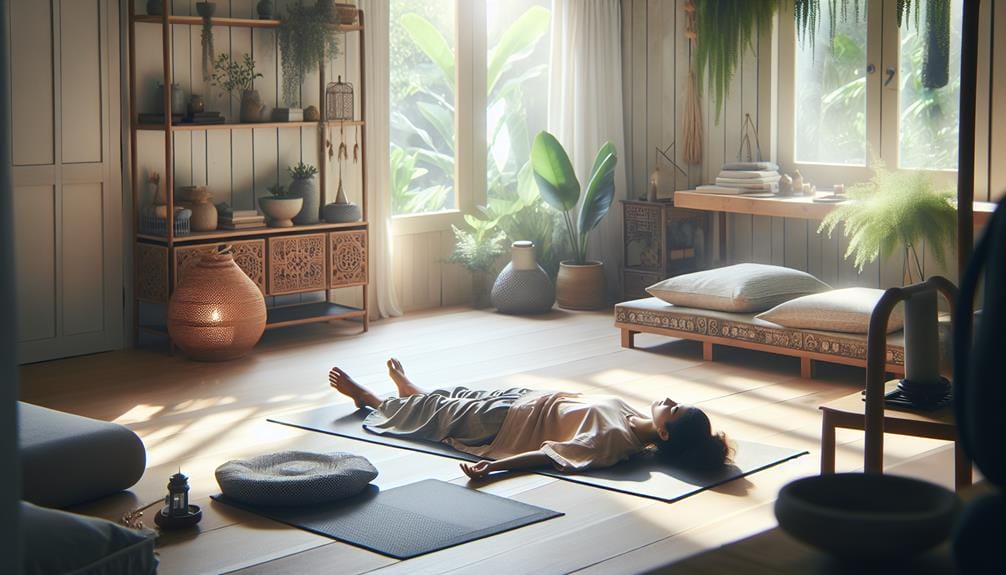
After energizing your body with Bridge Pose, it's time to allow yourself to fully relax and rejuvenate with Corpse Pose (Savasana).
Picture yourself lying on your back, arms and legs extended like a starfish that's had a long day at sea. This pose is your ticket to ultimate relaxation and stress relief.
As you lie still, focus on your breath and consciously relax each part of your body. Think of it as the lazy person's guide to stress relief. Savasana calms your nervous system, reduces anxiety, and sets the stage for better sleep.
It's like hitting the reset button, making it an essential part of any yoga practice. So, go ahead, embrace the stillness and let your body rejuvenate.
Conclusion
You've now got a solid foundation to start your yoga journey with these beginner poses. Did you know that practicing yoga for just 30 minutes a day can reduce stress by up to 30%?
Incorporate these poses into your daily routine, and you'll likely notice improvements in flexibility, strength, and mental clarity. Remember, consistency is key.
So, roll out your mat, take a deep breath, and embrace the transformative benefits of yoga.
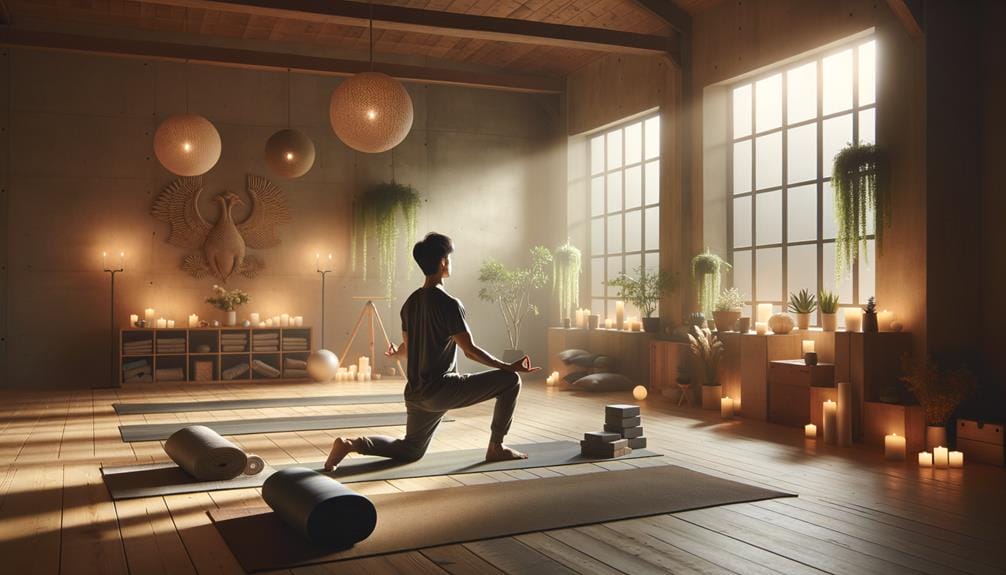






Leave a Comment